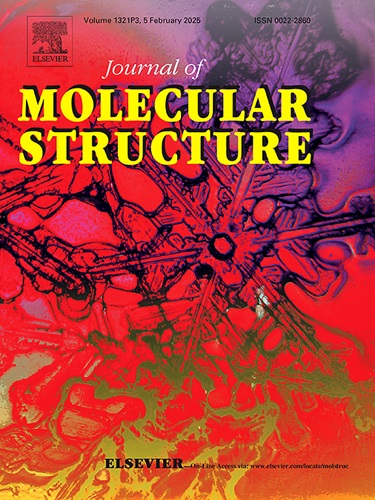钯(II)肟复合物:通过P53/Caspase-3途径合成、结构表征和对HepG-2细胞的抗增殖作用
IF 4
2区 化学
Q2 CHEMISTRY, PHYSICAL
引用次数: 0
摘要
制备了四齿肟有机配体(H2L)及其Pd(II)螯合物,并利用分析和光谱技术对其结构进行了鉴定。采用密度泛函理论方法对钯(II)基肟配合物进行几何优化和结构分析,并利用Expo 2014软件对[PdL]配合物光谱进行PXRD数据处理。微畸变的方平面是[PdL]复合体的配位多面体几何。对游离H2L和[PdL]与ct-DNA的结合能力进行了测试,所得结果与生物学研究和分子对接计算结果吻合较好。生物学研究结果表明,[PdL]复合物对多种人类癌细胞系具有显著的抗增殖作用,其中对HepG-2细胞的抑制作用最强。[PdL]复合物诱导细胞凋亡而不引起坏死,导致细胞周期阻滞在Pre G1和G2/M期,同时减少S期和细胞增殖。这种凋亡细胞死亡与P53/caspase 3通路相关,因为用[PdL]复合物处理导致P53表达增加和caspase 3的激活。此外,[PdL]复合物在治疗48小时后减少HepG-2细胞的转移,可能是由于其与癌细胞DNA的强结合亲和力。综上所述,[PdL]复合物具有诱导细胞凋亡、减少细胞增殖和转移的功能,是有效化疗药物的基本特征,因此具有作为肝癌化疗药物的潜力。本文章由计算机程序翻译,如有差异,请以英文原文为准。
Palladium(II) oxime complex: synthesis, structural characterization, and antiproliferative effects on HepG-2 cells via the P53/Caspase-3 pathway
Quadridentate oxime organic ligand (H2L) and its Pd(II) chelate were prepared and structurally elucidated using analytical and spectroscopic techniques. The geometry optimization and structural analysis of palladium(II)-based oxime complex was achieved by density functional theory approach and PXRD data processing of [PdL] complex spectrum by Expo 2014 software.
The slightly distorted square–planar is the coordination polyhedron geometry of [PdL] complex. The ability of free H2L and [PdL] to bind to ct-DNA was tested, and the results obtained showed good agreement with the results of biological studies and molecular docking calculations. The findings from biological studies demonstrate that the [PdL] complex has significant antiproliferative effects on various human cancer cell lines, with the strongest efficacy observed in HepG-2 cells. The [PdL] complex induces apoptosis without causing necrosis and leads to cell cycle arrest at the Pre G1 and G2/M phases while reducing the S phase and cell proliferation. This apoptotic cell death is associated with the P53/caspase 3 pathway, as treatment with the [PdL] complex results in increased P53 expression and activation of caspase 3. Furthermore, the [PdL] complex reduces metastasis in HepG-2 cells after 48 h of treatment, likely due to its strong binding affinity to cancer cell DNA. In conclusion, the [PdL] complex shows potential as a chemotherapeutic agent for liver cancer, as it can induce apoptosis and decrease both cell proliferation and metastasis, which are essential characteristics of effective chemotherapeutic agents.
求助全文
通过发布文献求助,成功后即可免费获取论文全文。
去求助
来源期刊

Journal of Molecular Structure
化学-物理化学
CiteScore
7.10
自引率
15.80%
发文量
2384
审稿时长
45 days
期刊介绍:
The Journal of Molecular Structure is dedicated to the publication of full-length articles and review papers, providing important new structural information on all types of chemical species including:
• Stable and unstable molecules in all types of environments (vapour, molecular beam, liquid, solution, liquid crystal, solid state, matrix-isolated, surface-absorbed etc.)
• Chemical intermediates
• Molecules in excited states
• Biological molecules
• Polymers.
The methods used may include any combination of spectroscopic and non-spectroscopic techniques, for example:
• Infrared spectroscopy (mid, far, near)
• Raman spectroscopy and non-linear Raman methods (CARS, etc.)
• Electronic absorption spectroscopy
• Optical rotatory dispersion and circular dichroism
• Fluorescence and phosphorescence techniques
• Electron spectroscopies (PES, XPS), EXAFS, etc.
• Microwave spectroscopy
• Electron diffraction
• NMR and ESR spectroscopies
• Mössbauer spectroscopy
• X-ray crystallography
• Charge Density Analyses
• Computational Studies (supplementing experimental methods)
We encourage publications combining theoretical and experimental approaches. The structural insights gained by the studies should be correlated with the properties, activity and/ or reactivity of the molecule under investigation and the relevance of this molecule and its implications should be discussed.
 求助内容:
求助内容: 应助结果提醒方式:
应助结果提醒方式:


